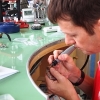Curved Glass - Easy Home Made Press
-
Recently Browsing
- No registered users viewing this page.
-
Topics
-
Posts
-
By coreymsnow · Posted
Excellent info, thank you! So when you say "conforms to the standard" does that mean, for example, that parts are interchangeable between brands and ages, or that you could use accessories built for that 110-year old one on a newer one that was built in the 1990s? Also, thank you for taking the time to answer my questions and your patience. -
It was first a brand, but became a standardized style. So you will find some older lathes actually marked "Webster Whitcomb" and many other makers who built WW lathes conforming to the same dimensions for spindle height, bed shape, attachment setup, collet size and design. https://www.lathes.co.uk/derbyshire/ So when someone mentions a WW lathe today, they are talking about any lathe that conforms to the standard, which could be a 110 year old American made lathe or a European made lathe from the 1960s or something else.
-
By watchweasol · Posted
Hi guys, just a little thank you for the CLOCKBARN site in America. I purchased a TIMETRAX APMLIFIER to help with setting clocks in beat from CLOCKBARN it arrived on time and when tested worked ok. A week later I had occasion to need it again, this time nothing the unit was dead. Checked out batteries , probes etc , nothing. I messaged CLOCKBARN to this effect. I got a prompt reply that he would send a replacement which duly arrived today and having tested it it’s ok. So I can recommend the site should you need to use it. The person,persons who run it are genuine guys. So thank you CLOCKBARN for your excellent service. -
Hi there! You have learned how professional watchmakers feel about Timex. It is very difficult to find one willing to work on them, for a few reasons: 1) a lot of them wrongly believe Timex cannot be serviced, are riveted together. This is a myth. 2) when serviced, they still cannot meet the performance standards of jeweled mechanical watches (-20sec/day is good enough for a Timex) 3) customers are unwilling to pay the watchmaker's hourly bench rates because the watches are worth very little The service manual for the M33 is available at https://heritage1854.com/m33 but you also need the M32 and M31 manuals because they build on each other (31 is the base, 32 has date, 33 has day and date) https://heritage1854.com/m31 https://heritage1854.com/m32 A stuck date changeover can be due to a missing, bent or broken detent spring (part 2576 in the manual) or the date wheel (2556) got stuck or separated from its post, or maybe disengaged from the hour wheel. With a little confidence, these are not difficult to repair and parts are pretty much interchangeable with any other Timex from the same era having the same features. So it is very easy to find inexpensive spares in the form of junk watches (don't bother trying to search for individual spare parts). My recommendation would be to find a junk Timex with an M25 (older manual wind with date) and practice a little with it. Follow the service manual from the same website. The automatics are a bit more difficult to work on but once you get a feel for how they fit together, you can make an attempt at your automatic and you would be able to use many spare parts from the M25 if necessary. To work with most Timex movements, you do not need a lot of tools. Just one screwdriver, 1.4mm is a good size, tweezers, and hand levers to remove the hands plus hand pusher tools to replace them. Of course if you want to do a full cleaning and restoration more is needed. But to get it apart and diagnose, only minimal tools.
-
By coreymsnow · Posted
I do indeed have some programming and electronics know-how. 3 decades writing code for a living, and playing with microcontrollers as a hobby. 🙂 It helps with my actual living of being a voice actor because I can maintain my own equipment- no one around to replace the caps or the tube in an obscure botique mic that isn't made or supported any longer. Also saves money maintaining and cleaning my own interfaces and mixers when they develop problems in the faders and such. That said... I do have a question that, I'm sure, will betray my ignorance about certain areas that I have yet to fill in. I understand a "WW" lathe is a "Webster Whitcomb", but from what I understand that is a style of lathe and not a brand, correct? If someone would be willing to clarify and maybe expand on the terminology, it would be helpful so I can better understand the advice being given and know what I need to look into to further my knowledge. For example, a Sherline mill would appear to be either a separate piece of gear or an attachment/expansion to their smaller lathe. When you say you have a WW lathe and a sherline mill, can you say exactly what devices you have? Thank you! (I just realized I have a few Raspberry Pis and some Arduinos of various form factors around here I could probably put to good use in a scenario like you describe above).
-





Recommended Posts